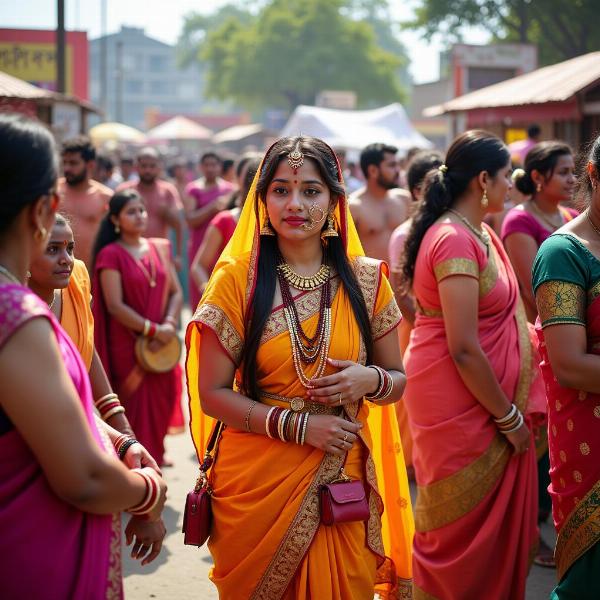Carnivalesque, a word borrowed from Western traditions, doesn’t have a direct, single-word equivalent in Hindi that captures its full essence. Understanding its meaning requires delving into the spirit of revelry, subversion, and social liberation it represents. When searching for “carnivalesque meaning in Hindi,” you’re likely seeking to understand how this concept translates into Indian cultural contexts. This article explores the various nuances of “carnivalesque” and how they manifest in vibrant Indian festivals and traditions.
Unmasking the Carnivalesque: A Celebration of Subversion
The carnivalesque, derived from the concept of “carnival,” embodies a temporary inversion of social hierarchies, a sanctioned release of pent-up energies, and a playful mockery of authority. Think of it as a period where societal norms are playfully challenged, and the mundane gives way to the extraordinary. This spirit of festive liberation finds resonance in various Indian traditions, though expressed through unique cultural lenses.
Holi: A Riot of Colors and Social Freedom
Perhaps the most prominent example of the carnivalesque in India is Holi. The festival of colors transcends social barriers, allowing individuals from all walks of life to engage in playful banter, drench each other in vibrant hues, and temporarily set aside social constraints. This sanctioned transgression of boundaries embodies the core of the carnivalesque spirit.
Diwali: The Triumph of Light over Darkness
While less overtly subversive than Holi, Diwali also carries elements of the carnivalesque. The celebratory atmosphere, the exchange of gifts, and the dazzling displays of fireworks create a sense of shared joy and communal participation. The symbolic victory of light over darkness can be interpreted as a temporary triumph over the challenges of everyday life.
Other Festive Expressions: From Local Fairs to Religious Processions
Beyond the major festivals, numerous local fairs, religious processions, and folk performances across India incorporate elements of the carnivalesque. These events offer opportunities for communities to come together, celebrate their shared identity, and engage in playful expressions of cultural identity.
 Indian Festival Celebration Community
Indian Festival Celebration Community
How to Translate “Carnivalesque” in Hindi: Capturing the Nuances
While a single word doesn’t encapsulate “carnivalesque,” Hindi offers various phrases to convey its different facets. “उत्सवी उल्लास” (utsavi ullas – festive joy) captures the celebratory aspect. “सामाजिक उलटफेर” (samajik ulatpher – social inversion) highlights the subversion of norms. “हँसी-मजाक” (hansi-mazaak – playful mockery) emphasizes the lighthearted and playful nature. Choosing the most appropriate phrase depends on the specific context.
Understanding the Intent Behind the Search
Someone searching for “carnivalesque meaning in Hindi” might be a student, a researcher, a translator, or simply someone curious about cultural comparisons. Providing a comprehensive explanation that caters to these diverse needs is crucial.
Beyond the Definition: Exploring the Cultural Significance
The carnivalesque is not merely a descriptive term; it’s a lens through which we can understand the social and psychological functions of festivals and rituals. By temporarily inverting social norms and allowing for sanctioned transgression, these events provide a crucial outlet for social pressures and contribute to the overall well-being of a community.
Conclusion: Embracing the Spirit of Carnivalesque
While “carnivalesque” lacks a direct Hindi equivalent, its essence resonates deeply within Indian culture. From Holi’s vibrant chaos to Diwali’s triumphant light, Indian festivals offer a rich tapestry of expressions that embody the spirit of revelry, subversion, and social liberation. Understanding this concept enriches our appreciation of the vibrant cultural landscape of India.
FAQ:
- What is the closest Hindi word to “carnivalesque”? There isn’t a single word, but phrases like “उत्सवी उल्लास” (utsavi ullas) and “सामाजिक उलटफेर” (samajik ulatpher) capture its different facets.
- Does the carnivalesque exist in Indian culture? Absolutely! Holi, Diwali, and numerous other festivals and traditions embody elements of the carnivalesque.
- Why is understanding the carnivalesque important? It provides insights into the social and psychological functions of festivals and their role in maintaining social harmony.
- How does the carnivalesque manifest in different cultures? While the core concept remains similar, the specific expressions vary greatly depending on cultural context.
- Are there any negative aspects to the carnivalesque? While generally celebratory, the temporary relaxation of norms can sometimes lead to excesses.
- Can you give an example of a local Indian festival with carnivalesque elements? Many village fairs and harvest festivals involve playful rituals and temporary role reversals.
- How can I learn more about Indian festivals and traditions? Research online, explore books on Indian culture, and experience these festivals firsthand if possible.
Meaning-Hindi.in is your trusted partner for all your Hindi translation needs. We offer a comprehensive range of translation services, including business and commercial documents, legal and certified translations, technical manuals, website localization, educational and academic materials, and specialized translations. Our expert linguists ensure accurate and culturally sensitive translations that meet the highest quality standards. Contact us today to discuss your translation project! Email: [email protected], Phone: +91 11-4502-7584. Meaning-Hindi.in is here to bridge the language gap and connect you to the vibrant world of Hindi.